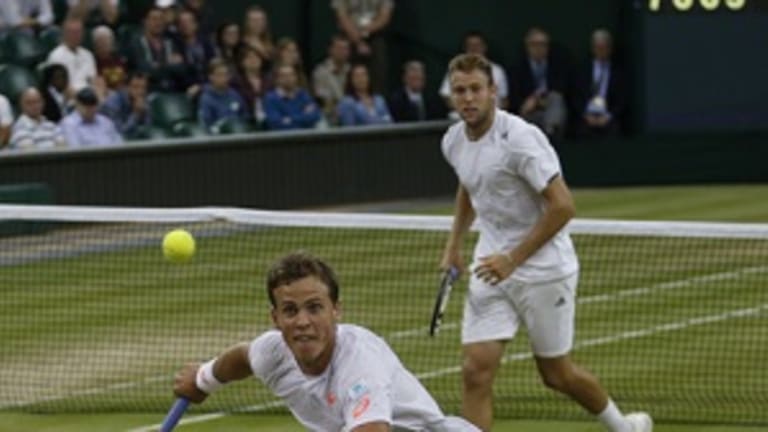From Fedal to Djokerer to Muzzovic, we now know that every men’s tennis rivalry can be boiled down to a single, semi-comical co-name. As far as I know, though, the trend hasn’t carried over to men’s doubles teams. The only example I can think of is Quisner, the late, not-so-great mash-up of John Isner and Sam Querrey.
Is it time for a new one? Jack Sock and Vasek Pospisil may be ready for the one-name treatment. In the past month, the 21-year-old American and 24-year-old Canadian have beaten the Bryan brothers in the Wimbledon final, followed it up with a title in Atlanta, and moved to No. 7 in the ATP’s doubles race to London in 2014. That’s not too shabby for a team that had never played together before. Can we start calling them...Popsockil?
No, it doesn’t exactly roll off the tongue, but Sock and Pospisil, who are 10-0 together, plan to keep going nonetheless. After a singles-only week in D.C., they’re scheduled for Toronto, Cincinnati, and the U.S. Open. For tennis fans, and especially doubles fans, that may be the best part of their story. The game could use a fresh new duo that sticks together for a while.
Many of us have talked for years about what it would take to get fans to care more about doubles. Show it more often on TV; increase the prize money; get the stars to play; schedule it on the biggest courts; put the players in uniforms. But I think Sock and Pospisil, with their back-to-back titles, have accidentally found another, simpler key to making doubles more compelling over the long run. It doesn't necessarily have to have the top names; what it needs, and rarely gets, are young singles players who succeed and stay together. I know that, after their infectiously entertaining performance at Wimbledon, I was interested in what Sock and Pospisil would do at their next event. There was a sense that they were an entity.
The men’s doubles rankings have featured plenty of full-time teams in recent years. The Bryans, Nestor-Zimonjic, Paes-Stepanek, Peya-Soares, Granollers-M. Lopez are all in or around the Top 10. But Sock and Pospisil are different in a few ways. They're new, and they're much younger—every player ranked above them at the moment is 30 or over; Nestor and Paes are 41. More important, Sock and Pospisil aren’t doubles specialists. If nothing else, the fact that in their first tournament together, they could beat the Bryans, Peya-Soares, Paes-Stepanek, and Bopanna-Qureshi, is proof that youth alone is more than a match for experience in doubles. That enthusiasm and energy is also something audiences respond to.
“We had a lot of fun,” Sock said when he was asked how he and Pospisil had won Wimbledon. “People could see that. I think that’s part of why we did well. We really enjoyed being out there, enjoyed the moment.”
Or, as Pospisil put it when he was asked what their game plan had been against the Bryans:
“Close your eyes; hope you play the best tennis of your life.”
